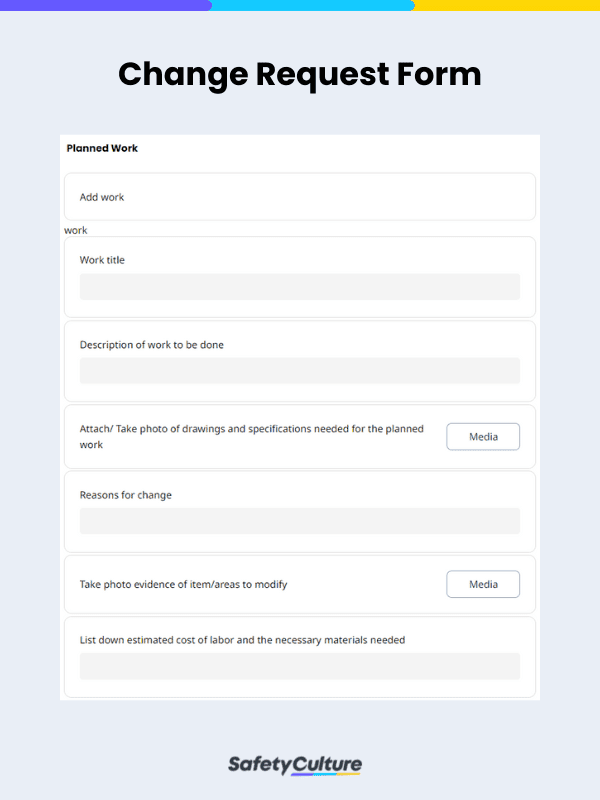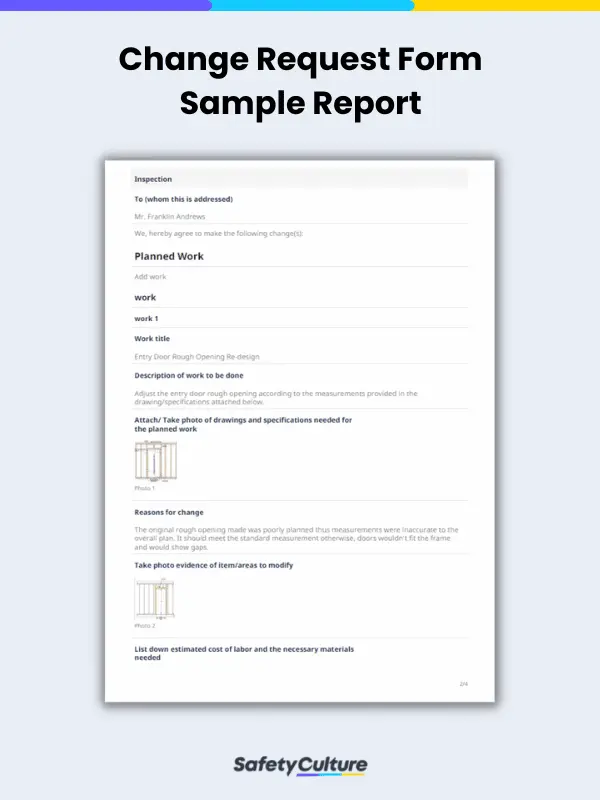What is a Change Request Form?
A change request form, also known as a change order form, is a formal proposal commonly used by contractors and stakeholders to make alterations to the project scope. Failure to issue change request forms as soon as problems are identified with the ongoing project can lead to potential legal and cost blowouts.
Why Use a Change Request Form Template
Implementing changes in a project isn’t something that can be done hastily or without going through a proper process. Since projects involve money, labor, and coordination, among others, any changes or modifications identified or requested must be processed and approved before commencing work.
The first step in effectively dealing with project changes that may arise is collecting data to help determine the best course of action to accommodate them. Using a change request form template helps the bigger change management process be more streamlined, organized, and well-documented.
What Should a Change Request Include?
The key elements of a change request form template include the following:
- Basic details such as change order number, contract number, job name and number, job location, and name of who requested the change
- Planned work, work title, and description of the work to be done
- Photos and evidentiary support of the specifications needed for the planned work
- Estimated cost of labor and materials
- Name and signature of authorized contractor and owner
How to Write a Change Request Form
Using a template lets you easily fill in the needed information so you won’t overlook any detail. You may follow these steps to complete a change request form template:
- Fill in the basic details about the project and change request. These include the change order number, contract number, job name and number, job location, and who requested the change.
- Specify the work needing to be done. Attach photos and indicate reasons for further context.
- Include evidentiary documentation to support the change request.
- List down the estimated cost of labor and needed materials. Also, indicate if there’s any required time extension.
- Complete the template by collecting signatures from the authorized contractor and owner once the specified changes have been agreed upon, deemed satisfactory, and accepted.
Best Practices in Issuing Change Request Forms
Modifications to the original work scope may be necessary in the event of unexpected site conditions, poorly defined project scope, or drawing/plan errors. In such cases, change order forms can help quantify potential costs and ensure that concerned parties are in agreement. Here is the ideal sequence to follow in the issuance, approval, and documentation of a change request form:
Step 1: Communicate with the owner.
Notify the owner and determine whether he/she is considering making adjustments beyond the original work scope provided in the contract. This way, the needed changes can be properly assessed and documented before implementation.
Step 2: Create a change request form.
In drafting the project change request form, describe the planned work in detail. This involves providing new design documents, drawings, and/or specifications to illustrate the changes clearly. Estimated costings for labor, materials, and equipment should be indicated together with the new project schedule.
Step 3: Submit the change request form and quotation to the owner.
Submit the change request form and supporting documents required (i.e., original contract, revised drawings, construction daily reports, etc.) along with the quotation prepared by the contractor. During this step, negotiations will most likely occur regarding the quotation. Once all parties involved in the project agree on the potential work to be done, everyone will sign off and proceed to do the work. Otherwise, a rewrite of the change request will be made.
Step 4: Commence works.
Once the issued change request has been signed off, planned works should be carried out according to the revised project schedule. All stakeholders involved in the process must be well-informed about the scope of work to ensure that the details stated therein are being followed.
Step 5: Do a quality check.
After implementing the modifications on the project, contractors should conduct an inspection to ensure that the conditions stated in the issued change request form have been successfully met. Document the inspection by taking photos to reduce the chances of liability for problems found after work completion.
FAQs About Change Requests
In general, the types of change requests can be classified into two categories:
- Inside-the-scope change requests – These refer to changes that typically involve minor revisions or corrections to the original or existing project scope and requirements. Hence, these are considered to have little impact on the overall cost, timeline, and coordination needed for implementation.
- Outside-the-scope change requests – On the contrary, this type of change request deals with changes that take more time to accomplish and have a big impact on the overall project.
Since changes can come from various aspects of the project, any stakeholder involved can write and submit a change request as needed. In most cases, though, change request forms are created by project managers, clients, sponsors, or authorized contractors.
In project management, there are various stakeholders in charge of approving change requests depending on several variables in a project. These considerations include the project size, contract requirements, and external parties involved. Commonly, the ones who approve change requests are the project sponsors, project managers, and the Change Control Board (CCB).




